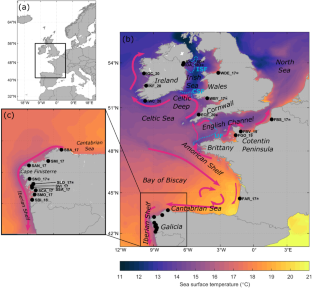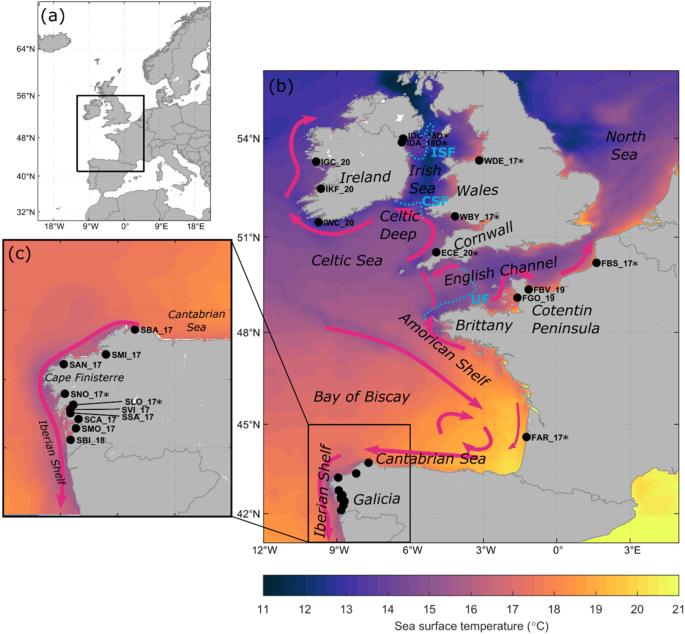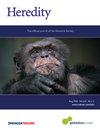东北大西洋普通海雀(Cerastodema edule)的异质微地理遗传结构:生物地理屏障和环境因素。
IF 3.9
2区 生物学
Q2 ECOLOGY
引用次数: 0
摘要
对遗传结构最好的了解对遗传资源的保护至关重要。尽管没有明显的障碍限制基因流动,但在海洋物种中已经显示出显著的遗传结构。普通海雀(Cerastoderma edule)是一种生活在东北大西洋的具有巨大商业和生态价值的双壳类动物。先前的种群基因组学研究表明,无论是在东北大西洋,还是在小地理区域内,都有显著的结构,这突出了研究精细规模结构的必要性。在这里,我们分析了两个可能代表该物种相反结构模式的地理区域:(1)不列颠群岛西南部地区,由于生物地理屏障而高度分散;(2)加利西亚(西班牙西北部),一个假定的同质区域。通过2b RAD对来自22个自然床的599个个体进行的总共9250个SNPs基因分型用于分析。整个SNP数据集大多证实了先前与遗传多样性和分化相关的观察结果;然而,中性和发散的SNP异常数据集能够将物理屏障与构成这两个区域的非生物环境因素解开。虽然加利西亚表现出均匀的结构,但不列颠群岛西南部地区被划分为四个与海洋特征和非生物因素(如海面盐度和温度)相关的可靠遗传区域。收集到的信息支持不列颠西南部和加利西亚地区的珊瑚礁资源的具体管理政策,同时考虑到其特殊的社会经济特征;此外,这些新数据将被添加到最近在东北大西洋报告的数据中,以确定该物种整个分布范围内的可持续管理行动。本文章由计算机程序翻译,如有差异,请以英文原文为准。


Heterogeneous microgeographic genetic structure of the common cockle (Cerastoderma edule) in the Northeast Atlantic Ocean: biogeographic barriers and environmental factors
Knowledge of genetic structure at the finest level is essential for the conservation of genetic resources. Despite no visible barriers limiting gene flow, significant genetic structure has been shown in marine species. The common cockle (Cerastoderma edule) is a bivalve of great commercial and ecological value inhabiting the Northeast Atlantic Ocean. Previous population genomics studies demonstrated significant structure both across the Northeast Atlantic, but also within small geographic areas, highlighting the need to investigate fine-scale structuring. Here, we analysed two geographic areas that could represent opposite models of structure for the species: (1) the SW British Isles region, highly fragmented due to biogeographic barriers, and (2) Galicia (NW Spain), a putative homogeneous region. A total of 9250 SNPs genotyped by 2b-RAD on 599 individuals from 22 natural beds were used for the analysis. The entire SNP dataset mostly confirmed previous observations related to genetic diversity and differentiation; however, neutral and divergent SNP outlier datasets enabled disentangling physical barriers from abiotic environmental factors structuring both regions. While Galicia showed a homogeneous structure, the SW British Isles region was split into four reliable genetic regions related to oceanographic features and abiotic factors, such as sea surface salinity and temperature. The information gathered supports specific management policies of cockle resources in SW British and Galician regions also considering their particular socio-economic characteristics; further, these new data will be added to those recently reported in the Northeast Atlantic to define sustainable management actions across the whole distribution range of the species.
求助全文
通过发布文献求助,成功后即可免费获取论文全文。
去求助
来源期刊

Heredity
生物-进化生物学
CiteScore
7.50
自引率
2.60%
发文量
84
审稿时长
4-8 weeks
期刊介绍:
Heredity is the official journal of the Genetics Society. It covers a broad range of topics within the field of genetics and therefore papers must address conceptual or applied issues of interest to the journal''s wide readership
 求助内容:
求助内容: 应助结果提醒方式:
应助结果提醒方式:


